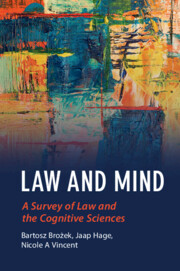Book contents
- Law and Mind
- Law and the Cognitive Sciences
- Law and Mind
- Copyright page
- Contents
- Figures
- Contributors
- Acknowledgements
- 1 Introduction
- I Metatheory and Methodology
- II Ontology and Epistemology
- III Legal Doctrine and Cognitive Sciences
- IV Evidence
- 17 Implications of Neurotechnology: Brain Recording and Intervention
- 18 Neuroimaging Evidence in US Courts
- 19 Neuroscientific Evidence in Context
- 20 Some Issues in Interpreting Neuroscientific Evidence
- 21 Explanation-Based Approaches to Reasoning about Evidence and Proof in Criminal Trials
- V Dissenting Opinions
- References
21 - Explanation-Based Approaches to Reasoning about Evidence and Proof in Criminal Trials
from IV - Evidence
Published online by Cambridge University Press: 21 April 2021
- Law and Mind
- Law and the Cognitive Sciences
- Law and Mind
- Copyright page
- Contents
- Figures
- Contributors
- Acknowledgements
- 1 Introduction
- I Metatheory and Methodology
- II Ontology and Epistemology
- III Legal Doctrine and Cognitive Sciences
- IV Evidence
- 17 Implications of Neurotechnology: Brain Recording and Intervention
- 18 Neuroimaging Evidence in US Courts
- 19 Neuroscientific Evidence in Context
- 20 Some Issues in Interpreting Neuroscientific Evidence
- 21 Explanation-Based Approaches to Reasoning about Evidence and Proof in Criminal Trials
- V Dissenting Opinions
- References
Summary
In this chapter the authors discuss explanation-based theories on reasoning about evidence and on proof in criminal trials that view such reasoning in terms of evaluating competing explanations. These theories are all grounded in the cognitive psychology of decision making. They aim to describe how people actually reason when they have to make sense of a great deal of evidence in, for example, criminal trials. According to these theories, people in such contexts typically construct one or more causal explanations for the evidence.
The explanation-based theories discussed in this chapter extend these empirical findings by developing theories that are, in varying degrees, normative. These theories are about the extent to which people actually reason in a rational manner, but also the extent to which they should change their manners. In particular, we discuss three theories, namely Allen and Pardo’s relative plausibility theory, Amaya’s theory of inference to the most coherent explanation and Van Koppen’s theory of anchored narratives or, as it has also been called, the scenario theory.
These three theories share three characteristics, namely that causal explanation, more specifically inference to the best explanation (IBE), is at their heart; that coherence is a core criterion to assess the quality of explanations; and that, as normative theories, they try to stay close to how people actually reason, both in everyday life and in criminal trials.
In the literature about evidence and proof in criminal law, explanation-based approaches are generally contrasted with probabilistic, more specifically Bayesian, approaches. Therefore, we discuss both Bayesian critiques of explanation-based approaches and explanation-based critiques of Bayesian approaches. We also discuss the question of whether a productive partnership between explanation-based and probabilistic approaches is possible.
- Type
- Chapter
- Information
- Law and MindA Survey of Law and the Cognitive Sciences, pp. 431 - 470Publisher: Cambridge University PressPrint publication year: 2021
References
- 6
- Cited by



